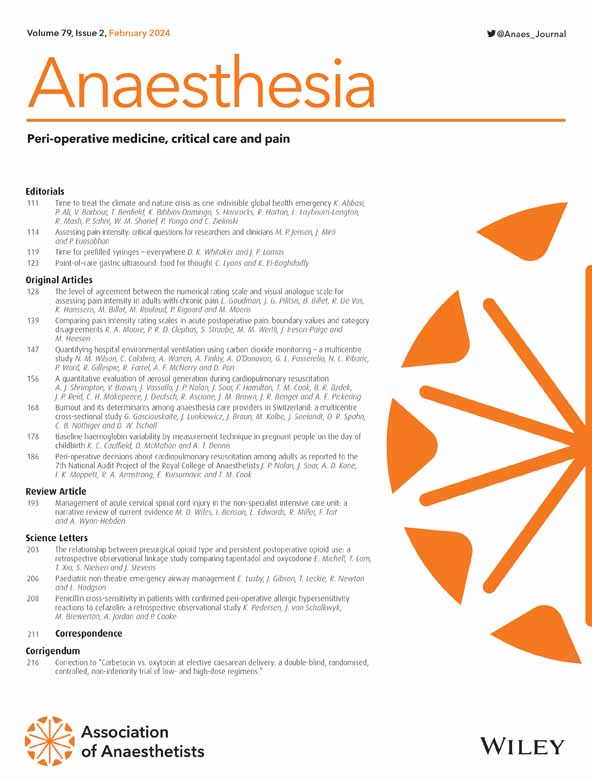选择性非心脏手术手术开始时间与术后死亡率、发病率和医疗保健利用之间的关系:一项使用倾向评分匹配的回顾性单中心研究
IF 6.9
1区 医学
Q1 ANESTHESIOLOGY
引用次数: 0
摘要
关于择期非心脏手术手术开始时间对术后结果的影响,目前所知有限。本研究调查了选择性非心脏手术的手术开始时间和手术结果之间的关系,包括死亡率;发病率;医疗保健的利用。方法我们分析了291051例接受非心脏手术的患者。患者按手术开始时间分组:上午(08:00-13:00)和下午(13:00-18:00)。计算限制平均生存时间以评估生存差异。结果也按工作日和季节分层。亚组分析评估了包括老年人在内的高危人群手术时机与预后之间的关系。结果倾向评分匹配后,上午组和下午组30天死亡率差异有统计学意义(0.12%比0.17%,p = 0.015);1年死亡率(2.73% vs. 3.36%, p < 0.001);复合并发症(5.48% vs. 5.94%, p = 0.003);ICU住院率(5.87% vs. 7.18%, p < 0.001);术中输血(3.40% vs. 4.10%, p < 0.001)。限制平均生存时间分析显示,下午组在所有时间点的生存时间都明显较短。下午手术与30天死亡风险增加相关(校正风险比1.33,95%CI 1.07-1.66, p = 0.010);1年死亡率(校正风险比1.26,95%CI 1.20-1.32, p < 0.001);复合并发症(校正优势比1.05,95%CI 1.01-1.08, p = 0.010);ICU住院(校正优势比1.09,95%CI: 1.06-1.13, p < 0.001);术中输血(校正优势比1.27,95%CI 1.21-1.33, p < 0.001)。亚组分析表明,手术开始时间对预后的影响在高危患者中更为明显,并且根据手术类型的不同也有显著差异。手术开始时间是术后短期和长期死亡率、发病率和医疗资源利用率增加的独立危险因素。造成这种情况的原因可能是多方面的。本文章由计算机程序翻译,如有差异,请以英文原文为准。
Association between surgical start time and postoperative mortality, morbidity and healthcare utilisation in elective non‐cardiac surgeries: a retrospective, single‐centre study using propensity score matching
SummaryIntroductionThere is limited knowledge regarding the impact of surgical start time on postoperative outcomes in elective non‐cardiac surgery. This study investigated the association between surgical start time and surgical outcomes in elective non‐cardiac surgeries, including mortality; morbidity; and healthcare utilisation.MethodsWe analysed 291,051 patients who underwent non‐cardiac surgery. Patients were grouped by surgical start time: morning (08:00–13:00) vs. afternoon (13:00–18:00). Restricted mean survival time was calculated to assess survival differences. Outcomes were also stratified by weekday and season. Subgroup analyses evaluated associations between surgical timing and outcomes in high‐risk populations, including older adults.ResultsAfter propensity score matching, statistically significant differences were observed between the morning and afternoon groups for 30‐day mortality (0.12% vs. 0.17%, p = 0.015); 1‐year mortality (2.73% vs. 3.36%, p < 0.001); composite complications (5.48% vs. 5.94%, p = 0.003); ICU admissions (5.87% vs. 7.18%, p < 0.001); and intra‐operative transfusions (3.40% vs. 4.10%, p < 0.001). Restricted mean survival time analysis revealed significantly shorter survival times in the afternoon group across all time points. Afternoon surgery was associated with increased risk of 30‐day mortality (adjusted hazard ratio 1.33, 95%CI 1.07–1.66, p = 0.010); 1‐year mortality (adjusted hazard ratio 1.26, 95%CI 1.20–1.32, p < 0.001); composite complications (adjusted odds ratio 1.05, 95%CI 1.01–1.08, p = 0.010); ICU admission (adjusted odds ratio 1.09, 95%CI: 1.06–1.13, p < 0.001); and intra‐operative transfusions (adjusted odds ratio 1.27, 95%CI 1.21–1.33, p < 0.001). Subgroup analysis indicated that the impact of surgical start time on outcomes was more pronounced in high‐risk patients and also varied significantly depending on the type of surgery.DiscussionSurgical start timing was an independent risk factor for increased short‐ and long‐term postoperative mortality, morbidity and healthcare resource utilisation. The reasons for this are likely to be multifactorial.
求助全文
通过发布文献求助,成功后即可免费获取论文全文。
去求助
来源期刊

Anaesthesia
医学-麻醉学
CiteScore
21.20
自引率
9.30%
发文量
300
审稿时长
6 months
期刊介绍:
The official journal of the Association of Anaesthetists is Anaesthesia. It is a comprehensive international publication that covers a wide range of topics. The journal focuses on general and regional anaesthesia, as well as intensive care and pain therapy. It includes original articles that have undergone peer review, covering all aspects of these fields, including research on equipment.
 求助内容:
求助内容: 应助结果提醒方式:
应助结果提醒方式:


